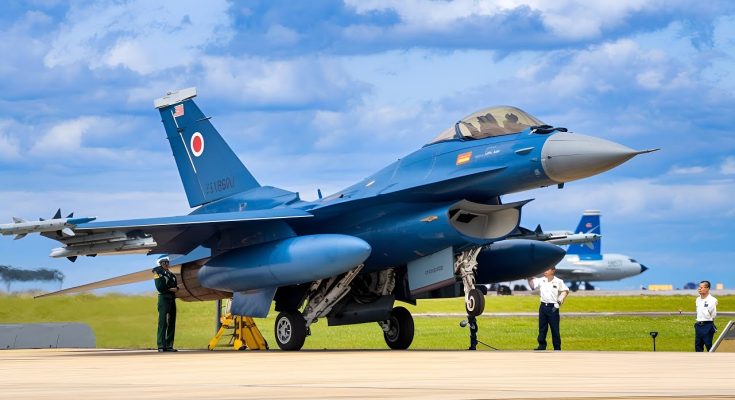F-16 Gets a Japanese Makeover and It’s Even BETTER!!!
The F-16 Fighting Falcon has long been one of the world’s most successful multirole fighter jets, serving as a versatile and cost-effective solution for air forces around the globe. But in Japan, the F-16 has undergone a remarkable transformation, enhanced with cutting-edge Japanese technology, creating an even more advanced and formidable aircraft. The Japanese version of the F-16, known as the F-2, combines the best of the F-16’s capabilities with indigenous upgrades that cater to Japan’s specific defense needs, making it a true powerhouse in the skies.
The F-16 and F-2: A Foundation for Improvement
The F-16, originally designed by General Dynamics (now Lockheed Martin) in the 1970s, has been one of the most successful fighter jets ever built. With its lightweight, agile airframe, and powerful engines, the F-16 has excelled in a wide variety of roles, from air superiority to ground attack missions. Over the years, it has been continuously updated to incorporate new technologies, making it a formidable presence in modern air forces.
However, Japan’s needs for its air defense were unique, prompting the country to take the F-16 as a base model and enhance it with indigenous Japanese technologies, creating the F-2. This collaboration between Mitsubishi Heavy Industries and Lockheed Martin resulted in a next-generation fighter jet that outperforms the original in several key areas, bringing Japan’s defense capabilities to new heights.
Key Upgrades: What Makes the F-2 Better?
1. Improved Radar Systems
One of the most significant upgrades to the F-2 is the integration of Japan’s advanced radar technology. The F-2 is equipped with the J/APG-1 radar, an indigenous, cutting-edge radar system developed by Japan’s Mitsubishi Electric. This radar offers superior performance compared to the original F-16’s radar. It provides enhanced detection range, greater resistance to jamming, and better tracking capabilities in a wide range of weather conditions. These improvements allow the F-2 to engage multiple targets more effectively and navigate through complex, high-threat environments with ease.
2. Enhanced Avionics and Cockpit
The F-2 features an upgraded avionics suite that incorporates Japan’s advanced technology, improving the aircraft’s overall operational efficiency. The cockpit is designed for better situational awareness, with state-of-the-art displays and controls that help the pilot manage the aircraft’s systems in real time. The F-2 also boasts a highly advanced Heads-Up Display (HUD) and a multi-function display, which allow the pilot to see critical information without having to look down, making decision-making faster and more intuitive.
In addition, the data link systems in the F-2 allow it to seamlessly integrate with other aircraft and military assets, providing a more connected and cohesive network for combat operations. This networked capability is essential for modern warfare, where real-time information sharing can be the difference between success and failure.
3. Increased Payload and Range
While the F-2 retains much of the F-16’s agility and performance, Japan’s version of the aircraft also has increased payload capacity and range. The F-2 has larger wings than the standard F-16, which enhances its stability and allows it to carry a wider variety of weapons. It can carry a broader range of air-to-air and air-to-ground missiles, as well as precision-guided bombs, providing it with greater versatility in both defensive and offensive missions.
The larger wings also give the F-2 a longer operational range, enabling it to conduct extended patrols and strikes over greater distances. This is particularly important for Japan, which has a vast airspace to defend, especially in the context of regional tensions and the need for long-range interception capabilities.
4. Superior Electronic Warfare Capabilities
Japan has also equipped the F-2 with advanced electronic warfare (EW) systems that are tailored to counter modern anti-aircraft threats. These systems help the F-2 detect, jam, and neutralize enemy radar and missile systems, making it much harder for adversaries to target the aircraft. The integration of Japan’s EW technology gives the F-2 a distinct advantage when operating in contested environments where advanced enemy air defense systems are a constant threat.
5. Better Maneuverability
The F-2’s enhanced airframe, particularly its larger wings, also contribute to its superior maneuverability compared to the original F-16. This improvement allows the F-2 to excel in dogfighting scenarios, with better stability and agility at both high and low speeds. The aircraft’s increased control surfaces also enable it to perform complex aerial maneuvers with greater precision, enhancing its air superiority capabilities.
Operational Role and Significance for Japan
The F-2 plays a crucial role in Japan’s air defense strategy. It serves as a versatile multirole fighter, capable of performing air superiority, interception, and precision strike missions. Its ability to quickly respond to threats and adapt to various operational roles makes it a critical asset for Japan’s Self-Defense Forces (JSDF).
The F-2 is also a key component of Japan’s response to regional security challenges, particularly in the context of growing tensions with neighboring nations like China and North Korea. The aircraft’s enhanced radar and weapons systems enable it to counter advanced air threats and perform long-range intercepts, ensuring that Japan’s airspace remains secure.
Conclusion: The F-2’s Legacy
The Japanese-made F-2 represents the perfect fusion of proven Western technology and advanced Japanese innovation. By taking the reliable F-16 platform and incorporating cutting-edge radar, avionics, and weapons systems, Japan has created a fighter jet that is not only more capable but also better suited to the country’s specific defense needs. The F-2 has enhanced Japan’s airpower, offering a combination of agility, firepower, and survivability that sets it apart from its predecessors.
As the F-2 continues to serve Japan’s air forces, it stands as a testament to Japan’s technological expertise and commitment to maintaining a robust and modern military force. It’s clear that Japan has made the F-16 even better, ensuring that the F-2 remains a formidable and versatile asset for years to come.



